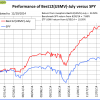This model trades in highly liquid large-cap stocks selected from those considered to be minimum volatility stocks of the S&P 500 Index. It produced a simulated survivorship bias free average annual return of about 36% from Jan-2000 to end of Dec-2014.
Minimum volatility stocks should provide exposure to the stock market with potentially less risk, seeking to benefit from what is known as the low-volatility anomaly. Consequently, they should show reduced losses during declining markets, but should also show lower gains during rising markets. However, our backtests show that better returns than the broader market can be obtained under all market conditions by selecting 8 of the highest ranked stocks of a universe made up from minimum volatility stocks of the S&P 500.

